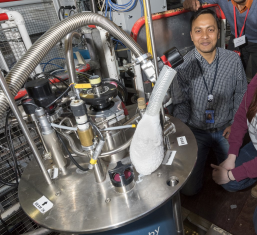Speaker
Description
Time-reversal symmetry breaking (TRSB) in superconductors is manifested by the spontaneous appearance of small magnetic fields in the superconducting state, and can be detected using techniques such as muon-spin relaxation (μSR) or measurements of the Kerr effect. The most notable examples of such superconductors are a handful of strongly correlated magnetic materials, such as Sr2RuO4 and some U-based heavy fermions, where unconventional superconducting pairing states are readily anticipated. However, in recent years TRSB has been found in a number of weakly-correlated superconductors which otherwise appear to have conventional properties, such as a fully open superconducting gap.
Here I will discuss two studies examining TRSB in superconductors using μSR. We recently found that CaPtAs is a superconductor below Tc = 1.5 K [2], which has a noncentrosymmetric tetragonal structure with 3D honeycomb networks of Pt-As. Our μSR measurements show evidence for time-reversal symmetry breaking below Tc, while the penetration depth derived from muon-spin rotation and the tunnel-diode-oscillator based method suggest a nodal superconducting gap [3]. Nodal superconductivity with TRSB is an unusual combination in weakly correlated noncentrosymmetric superconductors, suggesting that CaPtAs may bridge the gap between different classes of superconductor with TRSB.
The kagome lattice superconductors (K, Rb, Cs)V3Sb5 have attracted tremendous attention, in part due them hosting unconventional charge-ordered states that may exhibit TRSB among other unusual phenomena. Our zero-field μSR measurements of CsV3Sb5 reveal an increased relaxation in the charge-ordered state [4]. However, an increase in the relaxation rate persists in longitudinal-field measurements, suggesting a dynamic nature of the internal fields, and therefore they cannot be readily associated with TRSB.
References
[1] Sudeep Kumar Ghosh, Michael Smidman, Tian Shang James F Annett, Adrian D Hillier, Jorge Quintanilla and Huiqiu Yuan, J. Phys.: Condens. Matter 33 033001 (2021).
[2] Wu Xie, PeiRan Zhang, Bin Shen, WenBing Jiang, GuiMing Pang, Tian Shang, Chao Cao, Michael Smidman and HuiQiu Yuan, Science China Physics, Mechanics & Astronomy, 63, 237412 (2020).
[3] T. Shang, M. Smidman, A. Wang, L.-J. Chang, C. Baines, M. K. Lee, Z. Y. Nie, G. M. Pang, W. Xie, W. B. Jiang, M. Shi, M. Medarde, T. Shiroka and H. Q. Yuan, Phys. Rev. Lett. 124, 207001 (2020)
[4] Zhaoyang Shan, Pabitra K. Biswas, Sudeep K. Ghosh, T. Tula, Adrian D. Hillier, Devashibhai Adroja, Stephen Cottrell, Guang-Han Cao, Yi Liu, Xiaofeng Xu, Yu Song, Huiqiu Yuan, and Michael Smidman, Phys. Rev. Research 4, 033145 (2022)

